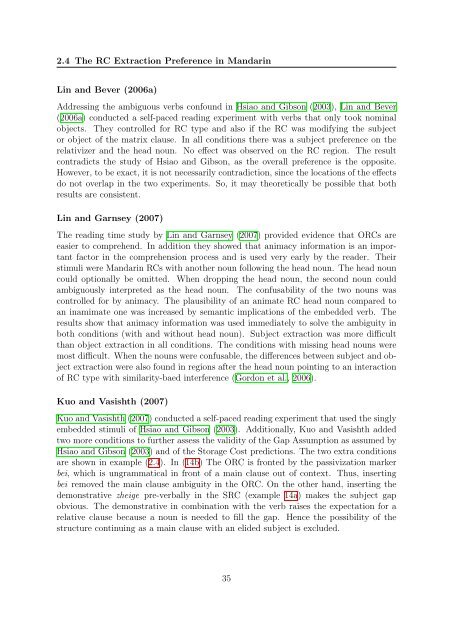Connectionist Modeling of Experience-based Effects in Sentence ...
Connectionist Modeling of Experience-based Effects in Sentence ...
Connectionist Modeling of Experience-based Effects in Sentence ...
You also want an ePaper? Increase the reach of your titles
YUMPU automatically turns print PDFs into web optimized ePapers that Google loves.
2.4 The RC Extraction Preference <strong>in</strong> Mandar<strong>in</strong><br />
L<strong>in</strong> and Bever (2006a)<br />
Address<strong>in</strong>g the ambiguous verbs confound <strong>in</strong> Hsiao and Gibson (2003), L<strong>in</strong> and Bever<br />
(2006a) conducted a self-paced read<strong>in</strong>g experiment with verbs that only took nom<strong>in</strong>al<br />
objects. They controlled for RC type and also if the RC was modify<strong>in</strong>g the subject<br />
or object <strong>of</strong> the matrix clause. In all conditions there was a subject preference on the<br />
relativizer and the head noun. No effect was observed on the RC region. The result<br />
contradicts the study <strong>of</strong> Hsiao and Gibson, as the overall preference is the opposite.<br />
However, to be exact, it is not necessarily contradiction, s<strong>in</strong>ce the locations <strong>of</strong> the effects<br />
do not overlap <strong>in</strong> the two experiments. So, it may theoretically be possible that both<br />
results are consistent.<br />
L<strong>in</strong> and Garnsey (2007)<br />
The read<strong>in</strong>g time study by L<strong>in</strong> and Garnsey (2007) provided evidence that ORCs are<br />
easier to comprehend. In addition they showed that animacy <strong>in</strong>formation is an important<br />
factor <strong>in</strong> the comprehension process and is used very early by the reader. Their<br />
stimuli were Mandar<strong>in</strong> RCs with another noun follow<strong>in</strong>g the head noun. The head noun<br />
could optionally be omitted. When dropp<strong>in</strong>g the head noun, the second noun could<br />
ambiguously <strong>in</strong>terpreted as the head noun. The confusability <strong>of</strong> the two nouns was<br />
controlled for by animacy. The plausibility <strong>of</strong> an animate RC head noun compared to<br />
an <strong>in</strong>amimate one was <strong>in</strong>creased by semantic implications <strong>of</strong> the embedded verb. The<br />
results show that animacy <strong>in</strong>formation was used immediately to solve the ambiguity <strong>in</strong><br />
both conditions (with and without head noun). Subject extraction was more difficult<br />
than object extraction <strong>in</strong> all conditions. The conditions with miss<strong>in</strong>g head nouns were<br />
most difficult. When the nouns were confusable, the differences between subject and object<br />
extraction were also found <strong>in</strong> regions after the head noun po<strong>in</strong>t<strong>in</strong>g to an <strong>in</strong>teraction<br />
<strong>of</strong> RC type with similarity-baed <strong>in</strong>terference (Gordon et al., 2006).<br />
Kuo and Vasishth (2007)<br />
Kuo and Vasishth (2007) conducted a self-paced read<strong>in</strong>g experiment that used the s<strong>in</strong>gly<br />
embedded stimuli <strong>of</strong> Hsiao and Gibson (2003). Additionally, Kuo and Vasishth added<br />
two more conditions to further assess the validity <strong>of</strong> the Gap Assumption as assumed by<br />
Hsiao and Gibson (2003) and <strong>of</strong> the Storage Cost predictions. The two extra conditions<br />
are shown <strong>in</strong> example (2.4). In (14b) The ORC is fronted by the passivization marker<br />
bei, which is ungrammatical <strong>in</strong> front <strong>of</strong> a ma<strong>in</strong> clause out <strong>of</strong> context. Thus, <strong>in</strong>sert<strong>in</strong>g<br />
bei removed the ma<strong>in</strong> clause ambiguity <strong>in</strong> the ORC. On the other hand, <strong>in</strong>sert<strong>in</strong>g the<br />
demonstrative zheige pre-verbally <strong>in</strong> the SRC (example 14a) makes the subject gap<br />
obvious. The demonstrative <strong>in</strong> comb<strong>in</strong>ation with the verb raises the expectation for a<br />
relative clause because a noun is needed to fill the gap. Hence the possibility <strong>of</strong> the<br />
structure cont<strong>in</strong>u<strong>in</strong>g as a ma<strong>in</strong> clause with an elided subject is excluded.<br />
35
















